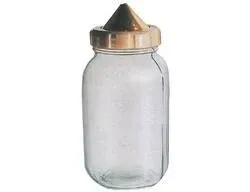What is Specific Gravity of Fine Aggregate (Sand)?
Sand particles composed of quartz have a specific gravity between 2.65 to 2.67. While inorganic clays generally range from 2.70 to 2.80. Soils with large amounts of organic matter or porous particles (such as diatomaceous earth) have specific gravity below 2.60 (Some range as low as 2.00).
What is Specific Gravity of Aggregates?

Determination of Specific Gravity of Fine Aggregate as per IS: 2386 Part-3 (1963)
Hi
friends, you are welcomed in the world of Civil Allied Gyan. Read
here definition, apparatus list, IS code, test procedure, formula and lab
report about determination of specific
gravity of fine aggregate.
- Pycnometer bottle of 1000ml capacity
- Taping rod
- Funnel
- Weighing Balance

- IS: 2386 (Part-3): 1963, Methods of test for aggregates for concrete (Determination of Specific Gravity of aggregates)
Procedure for Specific Gravity Test of Fine Aggregate:-
- Take a clean, dry pycnometer and determine its empty weight
(W₁ g).
- Take a clean sample of fine aggregate (about 1kg) for which
specific gravity is to be find out and transfer that to the pycnometer and
weight (W₂ g).
The aggregates finer than 6.3mm are taken.
- Pour distilled water in the pycnometer with aggregate sample at the temperature at 27 ºC, to just immerse sample.
- Immediately after immersion, remove the entrapped air from the sample by shaking or rotating the pycnometer, placing a finger on the hole at the top of the sealed pycnometer.
- Wipe out the outer surface of pycnometer. Now the pycnometer
is completely filled up with water till the hole at the top, and after
confirming that there is no more entrapped air in pycnometer, weight it (W₃ g).
- Transfer the aggregate of the pycnometer into a try care being taken to ensure that all the aggregate is transferred. Clean the pycnometer.
- Refill the pycnometer with distilled water up to the top of
the pycnometer, without any entrapped air. It should be completely dry from outside and
take the weight (W₄ g).
- For mineral filler, specific gravity bottle is used and the material is filled up to one-third of the capacity of bottle. The rest of the process of determining specific gravity is similar to the one described above.
|
Observation |
Trail No.1 |
Trail No. 2 |
|
Weight of pycnometer in air (W₁ g) |
|
|
|
Weight of pycnometer+ Fine aggregate (W₂ g) |
|
|
|
Weight of pycnometer + water + Fine aggregate
(W₃ g) |
|
|
|
Weight of pycnometer+ water in air (W₄ g) |
|
|
|
Apparent Specific Gravity: (W₂ – W₁)
/ (W₂ – W₁) - (W₃–W₄ )] |
|
|

- The specific gravity of aggregates normally used in
construction ranges from around 2.5
to 3.0 with an average value of about 2.68.
- Specific gravity of aggregates is considered as an indication of strength. Aggregates having higher specific gravity are generally considered as having higher strength and aggregates having low specific gravity are generally considered as having weaker strength.
|
Thanks for reading this article. Please, don’t forget
to share it. |

